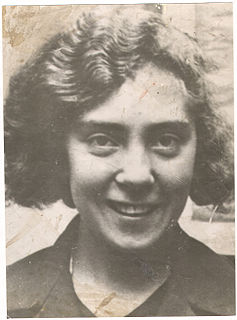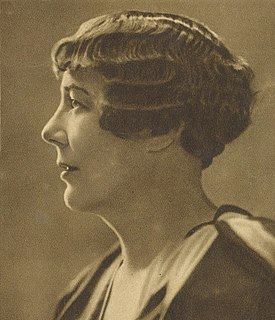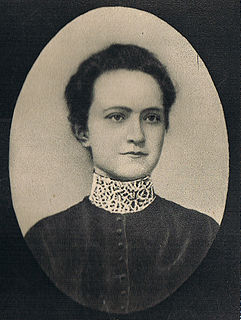 W
WTosia Altman was a courier and smuggler for Hashomer Hatzair and the Jewish Combat Organization (ŻOB) during the German occupation of Poland and the Warsaw Ghetto Uprising.
 W
WA well-known Holocaust photograph depicts three Jewish women who fought in the Warsaw Ghetto Uprising, took shelter in a bunker with a weapons cache, and were forced out by SS soldiers. One of the women, Bluma Wyszogrodzka (center), was shot. The other two, Małka Zdrojewicz (right) and Rachela Wyszogrodzka (left) were marched to the Umschlagplatz and deported to Majdanek concentration camp, where Wyszogrodzka was murdered. Jürgen Stroop, the SS officer who commanded the suppression of the uprising, admired the bravery of female combatants and included the photograph in one of the copies of his official report. The photograph has become symbolic of Jewish resistance to the Holocaust.
 W
WMira Fuchrer was a Polish Jewish activist of the Jewish resistance movement in the Warsaw Ghetto during the occupation of Poland in World War II; member of the Jewish Combat Organization (ŻOB), and fighter in Warsaw Ghetto Uprising of 1943. Surrounded by the Germans and their auxiliaries, she refused to surrender. It is believed that Mira committed suicide in the ghetto bunker with a group of her co-conspirators.
 W
WAla Gertner, referred to in other sources as Alla, Alina, Ella, and Ela Gertner, was one of four women hanged in the Auschwitz concentration camp for her role in the Sonderkommando revolt of October 7, 1944.
 W
WHaika Grossman was an Israeli politician and member of Knesset. In her youth, she was a Zionist leader in Europe, a partisan, and a participant in the ghetto uprisings in Poland and Lithuania.
 W
WIrena Morzycka-Iłłakowicz was a Polish second Lieutenant of the National Armed Forces and intelligence agent. The daughter of Bolesław Morzycki and Władysława Zakrzewska and the sister of Jerzy, she was also a polyglot who spoke seven languages: Polish, French, English, Persian, Finnish, German and Russian.
 W
WZofia Kossak-Szczucka was a Polish writer and World War II resistance fighter. She co-founded two wartime Polish organizations: Front for the Rebirth of Poland and Żegota, set up to assist Polish Jews to escape the Holocaust. In 1943, she was arrested by the Germans and sent to Auschwitz concentration camp, but survived the war.
 W
WWanda Krahelska-Filipowicz, code name “Alinka”” or “Alicja”, was a leading figure in Warsaw’s underground resistance movement throughout the years of German occupation during World War II in Poland, co-founder of Żegota. As the well-connected wife of a former ambassador to Washington, she used her contacts with both the military and political leadership of the Polish Underground to materially influence the underground's policy of aiding Poland's Jewish population during the war.
 W
WZivia Lubetkin was one of the leaders of the Jewish underground in Nazi-occupied Warsaw and the only woman on the High Command of the resistance group Żydowska Organizacja Bojowa (ŻOB). She survived the Holocaust in German-occupied Poland and immigrated to Mandate Palestine in 1946, at the age of 32.
 W
WTeresa Łubieńska, née Skarżyńska, a Polish countess, was a social activist, resistance fighter – lieutenant in the Polish Underground Army – and survivor of two Nazi concentration camps. After World War II, she settled in England, where she worked on behalf of Nazi camp survivors. In May 1957 she was the victim of an unprovoked and fatal stabbing at London's Gloucester Road tube station. The assailant was never traced.
 W
WAlina Margolis-Edelman was a Polish physician, Holocaust survivor and resistance fighter during the Warsaw Ghetto Uprising, who was forced to flee Poland during a revival of anti-Semitism in Poland in 1968. Joining Doctors Without Borders, she later helped found Doctors of the World, participating in medical missions in Africa and the Middle East, Latin America, and Eastern Europe. Simultaneously, she worked as a physician, practicing at Necker-Enfants Malades Hospital and the Maternal-Infant Protection Service in Seine-Saint-Denis. In 1990, she returned to Poland and began an association "Nobody's Children" to fight against child abuse in Poland. She was the recipient of numerous awards and honors.
 W
WAnna Louise Christine "Lone" Maslocha, also Masłocha, née Mogensen was a Polish-born Danish photographer who became a resistance fighter during the German occupation of Denmark in World War II. She was associated with the Polish-English intelligence service and with the Danish resistance movement Holger Danske and worked for the prominent Danish resistance member Citronen.
 W
WVladka Meed was a member of Jewish resistance in Poland who famously smuggled dynamite into the Warsaw Ghetto, and also helped children escape out of the Ghetto.
 W
WMaria Mirecka-Loryś is a Polish World War II freedom fighter. She is a member of the National Military Organization, Commander in Chief of the Women's National Military Union, member of the Union of Polish Women in America, and director of the National Board of the American Polish Congress.
 W
WSonia Shainwald Orbuch was an American Holocaust educator. During the Second World War she was a Jewish resistance fighter in eastern Poland.
 W
WFrumka Płotnicka was a Polish resistance fighter during World War II; activist of the Jewish Fighting Organization (ŻOB) and member of the Labour Zionist organization Dror. She was one of the organizers of self-defence in the Warsaw Ghetto, and participant in the military preparations for the Warsaw Ghetto Uprising. Following the liquidation of the Ghetto, Płotnicka relocated to the Dąbrowa Basin in southern Poland. On the advice of Mordechai Anielewicz, Płotnicka organized a local chapter of ŻOB in Będzin with the active participation of Józef and Bolesław Kożuch as well as Cwi (Tzvi) Brandes, and soon thereafter witnessed the murderous liquidation of both Sosnowiec and Będzin Ghettos by the German authorities.
 W
WWanda Wiktoria Półtawska is a Polish physician and author. She was a victim of the Ravensbrück concentration camp, just north of Berlin, having been arrested in February 1941 and charged with assisting the Polish resistance movement. She was used as a human guinea pig and became the subject of various medical experiments. She spent four years in the camp but survived her ordeal, and afterwards wrote an account of her experiences, And I Am Afraid of My Dreams. She later married and had four children.
 W
WZofia Poznańska, also known as Zosia, Zosha, or Sophia was a Polish antifascist and resistance fighter of the Soviet-affiliated espionage group that the German Abwehr intelligence service later called the "Red Orchestra".
 W
WHanka Sawicka, real name Hanna Krystyna Szapiro, pseudonym Hanka was a Polish communist, represented in Polish People's Republic propaganda as the first leader of the Union of Youth Struggle.
 W
WIrena Stanisława Sendler, also referred to as Irena Sendlerowa in Poland, nom de guerre Jolanta, was a Polish humanitarian, social worker, and nurse who served in the Polish Underground Resistance during World War II in German-occupied Warsaw. From October 1943 she was head of the children's section of Żegota, the Polish Council to Aid Jews.
 W
WAnna Smoleńska,, pseudonym "Hania", Polish student of art history at the University of Warsaw, author of the symbol of Fighting Poland during World War II, girl scout Gray Ranks.
 W
WEster (Estusia/Esterka) Wajcblum was a Jewish resistance fighter in the Auschwitz underground and one of four women hanged in the Auschwitz concentration camp for her role in the Sonderkommando revolt of October 7, 1944.
 W
WMaria Wittek served in the Polish Army and associated organizations from age 18 and, following retirement, in 1991 became the first Polish woman to be promoted to brigadier-general.
 W
WNatalia Zarembina was a Polish writer and journalist, activist of the Polish Socialist Party – Freedom, Equality, Independence, Council for Aid to Jews, and participant in the underground resistance movement in occupied Poland.
 W
WRachel (Sarenka) Zylberberg was an underground activist and participant in the Warsaw Ghetto Uprising. She held a key role in rousing the rebellion. Zylberberg was a member of Hashomer Hatzair, the Zionist-socialist youth movement. After the German invasion of Poland at the onset of World War II, she left the capital for Wilno in northeastern part of prewar Poland, then returned to Warsaw together with Chajka (Chaikeh) Grossman and was actively involved in the Jewish resistance.